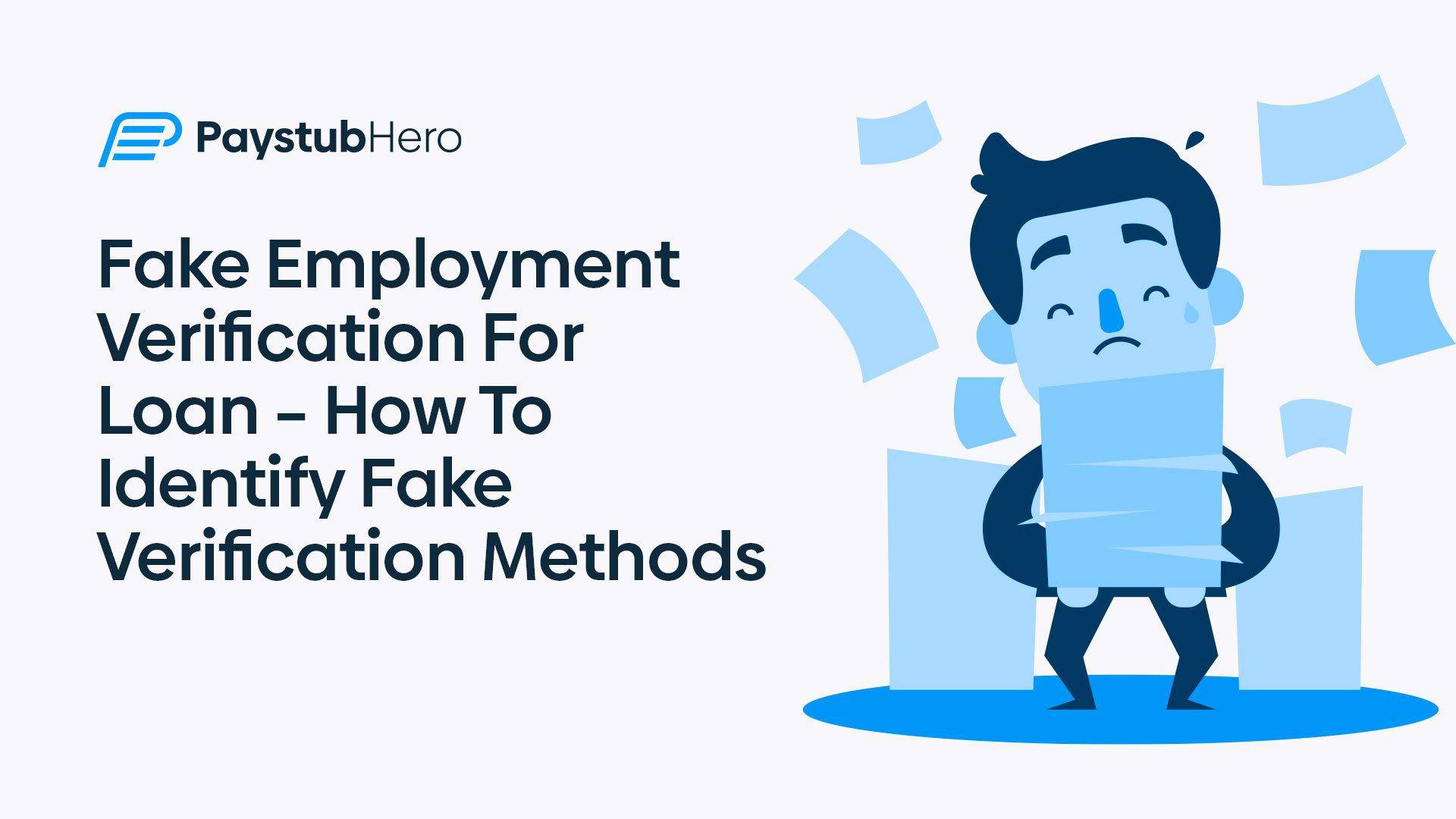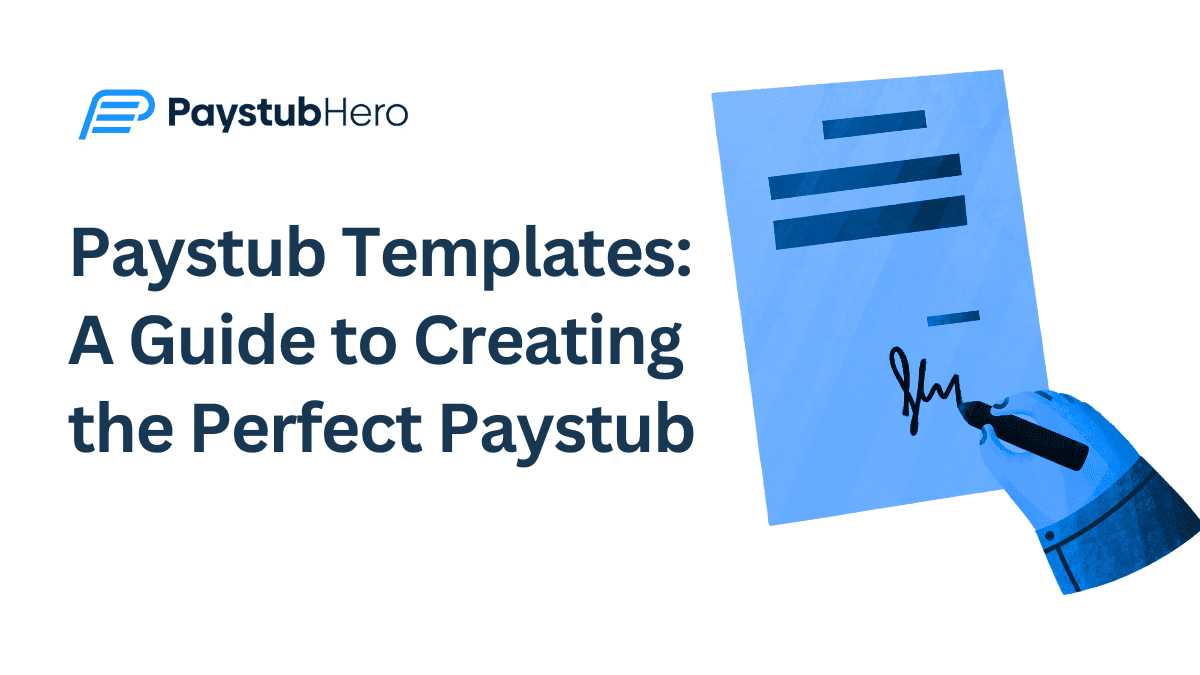As our world becomes increasingly digitized, the financial landscape isn’t exempted from the sweeping changes. Loans, once an arduous and paperwork-laden process, are now just a click away.
However, the convenience brought by the digital revolution has its drawbacks. In the financial sphere, one such issue is fake employment verification for loans.
You’re probably wondering, what is fake employment verification for a loan? Essentially, it’s a deceptive practice where an individual falsifies their employment or income status to secure a loan.
This could be achieved through counterfeit documents like check stubs or pay stubs, and the implications are far from minor. Engaging in such activities is not just ethically wrong, but it’s also illegal, leading to serious financial and legal consequences for all involved parties.
Furthermore, the problem is more prevalent than you might think. A quick search on the internet will introduce you to numerous websites offering different services, like paystubs now.
It’s a perplexing world out there, where the lines between authenticity and deceit are blurry. But don’t worry – we’re here to clarify, inform, and guide you through the process.
In this article, we’ll tackle the issue head-on. We’ll break down the concept, help you identify the red flags, and offer insight into how you can protect yourself and your business from this deceptive practice.
We aim to arm you with the knowledge and understanding you need to navigate this landscape confidently.
So, let’s delve deeper into the world of employment verification for loans, explore how fraudulent practices are perpetrated, and more importantly, how they can be identified and prevented. Let’s ensure you have the necessary tools to make informed decisions and secure your financial future.
Table of Contents
- Introduction
- Unpacking the Complexity of Fraudulent Employment Verification
- Decoding the Signs: Identifying Fake Verification Methods
- The Unassuming Document at Center Stage: The Role of the Pay Stub in Employment Verification
- Taking Action: What to Do if You Suspect Fraudulent Employment Verification
- Conclusion
- Call to Action
Unpacking the Complexity of Fraudulent Employment Verification
When it comes to the process of securing loans, fraudulent employment verification emerges as a significant concern. This issue is neither random nor insignificant, but rather a growing trend that’s impacting individuals, businesses, and financial institutions alike.
Fraudulent employment verification for loans essentially boils down to the act of presenting false employment or income information with the intention of securing a loan.
An individual might resort to using counterfeit check stubs or pay stubs, or even claim a non-existent job position, to mislead lending entities into believing that they have a steady source of income.
The end goal? To receive a loan approval that otherwise might not have been possible based on their actual employment status or income.
While the internet has made our lives undeniably easier, it’s also opened up avenues for such deceptive practices.
Websites like paystubsnow and others have cropped up, offering services that, on the surface, seem legitimate, but could potentially be misused for fraudulent purposes. It’s in this intricate web of seemingly authentic services and underlying deceit that the challenge truly lies.
Now, it’s crucial to note that engaging in fraudulent employment verification isn’t a grey area—it’s illegal. Beyond the moral implications, those found guilty could face severe financial and legal repercussions.
Lending institutions can take legal action against fraudsters, and the damage to the individual’s credit score could be irreparable.
Thus, understanding the nature of this issue, its implications, and ways to identify it is crucial for anyone looking to secure a loan or verify employment for lending purposes.
Knowledge, vigilance, and thorough scrutiny are your best defenses in the face of this complex problem.
With this in mind, let’s dive into the various red flags and prevention methods that can help you steer clear of the pitfalls of fake employment verification for loans.
Decoding the Signs: Identifying Fake Verification Methods
As complex as the issue of fake employment verification for loans may seem, there’s good news.
With a keen eye and a solid understanding of what constitutes a legitimate employment verification, it’s possible to uncover the signs of counterfeit practices. To equip you with this critical ability, let’s explore in-depth the primary identifiers of fake verification methods.
The Problem of Counterfeit Check Stubs
A check stub is an integral part of the loan approval process. It serves as a record of an individual’s salary, containing details such as gross pay, net pay, and any deductions.
However, counterfeit check stubs have become a common instrument in the toolkit of those engaging in fraudulent practices.
A suspicious check stub may exhibit inconsistencies in formatting, incorrect calculations, or unusual fonts and typesetting, which don’t align with standard professional documents.
Other signs could include missing information like the employer’s address, pay period dates, or inconsistencies between the amounts and figures listed. By comparing a dubious check stub with an authentic one, it becomes possible to identify these disparities.
The Role of Unscrupulous Loan Companies
The digital world is brimming with loan companies, each claiming to offer the best deals. While many are legitimate, like Honest Loans, others might not operate within legal boundaries.
Such companies could facilitate fraudulent practices, either unknowingly or deliberately, by not conducting thorough employment or income verifications. If a loan company’s process seems overly simplified or hasty, it’s worth doing more research to ascertain their credibility.
The Trap of Too-Good-To-Be-True Offers
One common thread runs through most fraudulent practices – they often present as ‘too-good-to-be-true’ offers. Individuals or companies might offer loans without proper income or employment verification, or promise approval despite poor credit history. Remember, in the world of finance, anything that seems unusually easy or guaranteed should be approached with caution.
By familiarizing yourself with these red flags, you can effectively identify fake employment verification methods and safeguard yourself against potential fraud.
However, recognizing these signs is just one part of the equation. Knowing what constitutes an authentic verification process, especially when it comes to critical documents like pay stubs, is equally vital. Let’s turn our attention to that aspect next.
The Unassuming Document at Center Stage: The Role of the Pay Stub in Employment Verification
Often, we underestimate the significance of certain documents in our lives, only realizing their value when we come across a situation that demands them. A pay stub is one such document.
This seemingly unassuming piece of paper or digital document plays a pivotal role in employment verification, especially when it comes to securing loans.
So, what exactly is a pay stub? A pay stub, also referred to as a paycheck stub or payslip, is a document given to an employee as proof of their earned salary. It breaks down their earnings, displaying gross pay, deductions for taxes, health benefits, retirement contributions, and the final net pay.
In the context of a loan application, a pay stub provides evidence of consistent income and financial stability, thereby giving lenders confidence in an applicant’s ability to repay the loan.
Unfortunately, this crucial document can become a tool for deceit in the hands of fraudsters, leading to fake employment verification for loans.
Fake pay stubs might display inconsistencies in calculations, suspiciously round numbers, or lack the standard details expected in an authentic document.
Given the significance of a pay stub in employment verification, it’s vital for both employees and employers, especially those in the freelance or small business world, to understand how to create authentic and accurate pay stubs.
Enter online payroll software like Paystubhero, a robust solution designed specifically for entrepreneurs, freelancers, small businesses, and independent contractors. Unlike traditional payroll services that cater to large corporations, Paystubhero provides a simplified yet efficient platform for generating professional and accurate pay stubs.
Armed with the knowledge of what constitutes a genuine pay stub and how to create one, you’ll be better prepared to spot fake ones. This insight will serve as a powerful tool in your fight against fraudulent employment verification for loans.
It’s time to demystify the complex process of loan verification and reclaim control over your financial security.
Taking Action: What to Do if You Suspect Fraudulent Employment Verification
It’s one thing to be able to identify signs of fraudulent employment verification for loans; knowing how to react to such situations is another equally vital piece of the puzzle. Taking appropriate action not only helps protect your interests but also contributes to the larger fight against financial fraud.
So, what should you do if you find yourself faced with potential fraudulent employment verification? Here are some proactive steps you can take.
- Report Your Suspicions: If you suspect that a loan applicant has provided fake employment verification, it’s crucial to report the issue to the appropriate authorities. This could be a supervisor or manager within your organization or, in severe cases, law enforcement agencies. Your action could potentially prevent further fraudulent activity.
- Protect Your Personal and Financial Information: In a situation where you believe a lending company isn’t thoroughly verifying employment or income details, protect your personal and financial information. Do not provide sensitive data unless you are confident of the company’s legitimacy and security measures.
- Consult with a Financial Advisor or Attorney: If you’re uncertain about the validity of a document or a loan offer, don’t hesitate to seek professional help. Consulting with a financial advisor or attorney can provide you with guidance and help clarify any doubts. Remember, it’s better to be safe than sorry.
- Educate Yourself and Others: Knowledge is power. The more informed you are about legitimate loan processes and authentic employment verification methods, the better equipped you are to spot fakes. Make an effort to educate yourself about the standard practices in your industry or region, and share this knowledge with colleagues, friends, and family.
By understanding the steps to take in the face of potential fraudulent activity, you can play a vital role in combating the issue of fake employment verification for loans. This doesn’t merely serve to protect your personal interests, but also contributes to a more transparent and secure financial landscape for everyone.
Remember, while spotting red flags is crucial, having a comprehensive plan of action is what truly empowers you to tackle such situations effectively.
Conclusion
Detecting fake employment verification for loans can be a complex task, but with knowledge and vigilance, you can protect yourself and your business.
By understanding what a legitimate pay stub looks like and knowing the red flags of fraudulent activity, you’ll be well-equipped to navigate the world of loan verification.
Need help with your pay stubs? At Paystubhero, we’ve got your back. Our online payroll software is designed specifically for entrepreneurs, freelancers, small businesses, and independent contractors.
With us, creating accurate and professional pay stubs is as easy as 1-2-3.
Don’t get caught in the confusion of fake employment verifications – let Paystubhero be your trusted guide in the world of employment verification. Give us a try today!
Frequent Asked Questions
Do lenders actually verify employment?
- Yes, lenders typically verify employment as part of the loan application process. This helps them assess the borrower’s ability to repay the loan.
How do I prove my employment for a loan?
- Employment can be proven through documents such as recent pay stubs, a letter from your employer, or bank statements showing direct deposit from an employer.
How serious is employment verification?
- Employment verification is extremely serious. It’s a crucial step in the lending process to ensure the borrower has a stable income source to repay the loan.
Do banks verify if you have a job to get a loan?
- Yes, banks generally verify employment when considering loan applications. This may involve contacting the employer directly or requesting employment-related documents.









